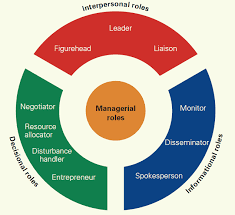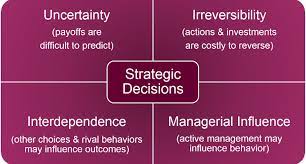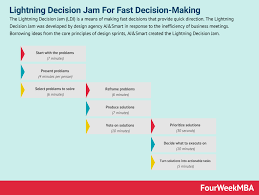Operational, Tactical, and Strategic Decision Making: Understanding the Differences
In the business world, decision making is an integral part of everyday operations. From day-to-day tasks to long-term planning, organizations rely on effective decision making to achieve their goals and stay competitive. However, not all decisions are created equal. There are different levels of decision making that require distinct approaches and considerations. In this article, we will explore the differences between operational, tactical, and strategic decision making.
Operational Decision Making:
Operational decisions are made on a daily basis and are typically routine in nature. They involve the day-to-day activities that keep an organization running smoothly. These decisions are often made by lower-level managers or employees who have direct knowledge and expertise in their respective areas.
Examples of operational decisions include managing inventory levels, scheduling shifts for employees, or determining which suppliers to work with. These decisions are usually guided by established policies and procedures within the organization.
Tactical Decision Making:
Tactical decisions bridge the gap between operational and strategic decision making. They focus on medium-term goals and involve allocating resources to achieve specific objectives. Tactical decisions are made by middle-level managers who have a broader perspective than those involved in operational decision making.
These decisions often involve analyzing data and considering various alternatives before choosing the best course of action. Examples of tactical decisions include developing marketing campaigns, adjusting pricing strategies, or optimizing production schedules.
Strategic Decision Making:
Strategic decisions have a long-term impact on an organization’s overall direction and success. They involve setting organizational objectives, formulating strategies to achieve those objectives, and allocating resources accordingly. Strategic decisions are typically made by top-level executives who have a holistic view of the organization’s mission and vision.
These decisions often require extensive analysis of market trends, competitive landscapes, and internal capabilities. Examples of strategic decisions include entering new markets or industries, adopting new technologies or business models, or restructuring the organization’s hierarchy.
Key Differences:
While all three levels of decision making are crucial for an organization’s success, they differ in terms of scope, time horizon, and the level of impact they have.
Operational decisions are focused on short-term tasks and have a limited impact on the overall direction of the organization. Tactical decisions bridge the gap between operational and strategic decisions, focusing on medium-term goals and resource allocation. Strategic decisions, on the other hand, have a long-term impact on the organization’s overall strategy and direction.
Furthermore, operational decisions are often made based on established policies and procedures, while tactical and strategic decisions require more analysis and evaluation of various alternatives.
In conclusion, understanding the differences between operational, tactical, and strategic decision making is essential for effective management. By recognizing the unique characteristics of each level and applying appropriate decision-making models and techniques, organizations can make informed choices that drive their success in both the short and long term.
6 Essential Tips for Effective Operational, Tactical, and Strategic Decision Making
- Consider the long-term impact of your decisions – think about how they will affect your organization in the future.
- Make sure you have all the facts and information before making a decision.
- Take into account the opinions of key stakeholders when making strategic decisions.
- Analyze risks and rewards associated with each decision to ensure it is the best choice for your organization.
- Utilize data and analytics to make informed, evidence-based decisions when possible.
- Monitor progress regularly to ensure that operational tactics are being implemented correctly and achieving desired results over time
Consider the long-term impact of your decisions – think about how they will affect your organization in the future.
Consider the Long-Term Impact of Your Decisions: A Key Aspect of Effective Decision Making
In the fast-paced business world, decision making is often focused on immediate results and short-term gains. However, it is crucial to step back and consider the long-term impact of our decisions. By taking the time to think about how our choices will affect our organization in the future, we can make more informed and strategic decisions.
When making operational, tactical, or strategic decisions, it is easy to get caught up in the urgency of the moment or the pressure to achieve immediate goals. While these considerations are important, neglecting the long-term consequences can lead to unintended negative outcomes.
Considering the long-term impact of our decisions involves envisioning how they will shape our organization’s future trajectory. Will they align with our overall mission and values? Will they contribute to sustainable growth and success? These are questions that need careful consideration.
For operational decisions, such as managing inventory levels or choosing suppliers, thinking about their long-term impact means considering factors like supplier reliability, product quality, and customer satisfaction over time. Making short-sighted decisions based solely on cost savings may result in compromised quality or strained relationships in the long run.
In tactical decision making, like developing marketing campaigns or adjusting pricing strategies, considering the long-term impact involves analyzing market trends and customer preferences. It means understanding how these choices will position your organization in relation to competitors and whether they will build a strong brand reputation for years to come.
Strategic decision making requires a deep understanding of how choices today will shape your organization’s future. Whether it’s entering new markets or adopting new technologies, considering their long-term impact is crucial for sustainable growth and competitive advantage.
By taking a step back and evaluating potential outcomes beyond immediate results, we can make more informed decisions that align with our organization’s vision and goals. It allows us to anticipate challenges and seize opportunities that may arise down the line.
In conclusion, considering the long-term impact of our decisions is a critical aspect of effective decision making. By incorporating this perspective into our operational, tactical, and strategic choices, we can make decisions that not only drive short-term success but also position our organizations for long-term growth and resilience. So, let’s take the time to think beyond the present and make decisions that will shape a brighter future for our organizations.
Make sure you have all the facts and information before making a decision.
When it comes to decision making, one of the most crucial tips to keep in mind is the importance of having all the facts and information at your disposal. Whether you’re making an operational, tactical, or strategic decision, being well-informed is key to making sound choices that lead to positive outcomes.
In today’s fast-paced world, it can be tempting to make quick decisions based on limited information or gut instincts. However, this approach can often lead to unintended consequences and missed opportunities. By taking the time to gather all relevant facts and information before making a decision, you can increase your chances of success.
Having all the facts means conducting thorough research, gathering data, and seeking input from various sources. This may involve consulting subject matter experts, analyzing market trends, studying past performance data, or conducting surveys or interviews. The more comprehensive your understanding of the situation at hand, the better equipped you’ll be to make an informed decision.
Additionally, it’s important to consider both quantitative and qualitative information when evaluating options. While numbers and statistics provide valuable insights, don’t overlook the power of subjective factors such as customer feedback or employee perspectives. A well-rounded view will help you make a more balanced decision that takes into account all relevant aspects.
By ensuring that you have all the facts and information before making a decision, you can minimize risks and increase your chances of achieving desired outcomes. It allows you to evaluate alternatives more accurately and make choices based on evidence rather than assumptions or guesswork.
Moreover, having a solid understanding of the facts provides confidence in your decision-making process. It enables you to communicate your rationale effectively with stakeholders who may be affected by or involved in implementing your decisions.
In conclusion, whether you’re making operational decisions that impact day-to-day activities or strategic decisions that shape long-term goals for your organization, remember this essential tip: gather all the facts and information before making a decision. It’s a fundamental step towards making informed choices that lead to success. So, take the time to research, analyze, and consider all relevant factors before taking action. Your decision-making process will be stronger, and the outcomes more favorable as a result.
Take into account the opinions of key stakeholders when making strategic decisions.
When it comes to strategic decision making, one valuable tip is to take into account the opinions of key stakeholders. Strategic decisions have far-reaching consequences and can impact various individuals and groups both within and outside the organization. By considering the perspectives of these key stakeholders, decision makers can gain valuable insights that can shape their strategic choices.
Stakeholders are individuals or groups who have a vested interest in the outcomes of a decision. They can include employees, customers, suppliers, shareholders, community members, and even regulatory bodies. Each stakeholder brings a unique perspective and set of concerns to the table.
By actively seeking out and listening to the opinions of these stakeholders, decision makers can gain a more holistic understanding of potential impacts and risks associated with different strategic options. This inclusive approach helps in avoiding blind spots and ensures that decisions are not made in isolation.
Engaging with stakeholders also fosters trust and transparency within the organization. When people feel valued and heard, they are more likely to support the decisions made, even if they don’t fully agree with them. This buy-in from stakeholders is crucial for successful implementation of strategic initiatives.
Incorporating stakeholder opinions doesn’t mean that every suggestion or preference should be followed blindly. Decision makers should carefully evaluate each viewpoint against other factors such as market trends, financial considerations, and organizational capabilities. However, by considering stakeholder perspectives alongside other relevant information, decision makers can make more informed choices that take into account a broader range of interests.
In conclusion, taking into account the opinions of key stakeholders is an essential practice when making strategic decisions. By actively seeking out diverse perspectives and incorporating them into the decision-making process, organizations can increase their chances of making sound strategic choices that align with their values while minimizing potential negative impacts. This inclusive approach not only leads to better decision outcomes but also strengthens relationships with stakeholders in the long run.
Analyze risks and rewards associated with each decision to ensure it is the best choice for your organization.
Analyzing Risks and Rewards: A Crucial Aspect of Decision Making
In the dynamic business landscape, decision making is a constant challenge. Organizations face numerous choices that can impact their success and long-term sustainability. When it comes to operational, tactical, and strategic decision making, one crucial tip stands out: analyzing risks and rewards associated with each decision. This practice ensures that the chosen path is the best choice for your organization.
Every decision carries inherent risks and potential rewards. By thoroughly assessing these factors, organizations can make more informed choices that align with their goals and values. Here’s why analyzing risks and rewards is so vital in the decision-making process:
Identifying Potential Pitfalls:
Analyzing risks allows organizations to identify potential pitfalls or obstacles that may arise from a particular decision. These risks could include financial implications, operational challenges, legal considerations, or reputational damage. By understanding these potential drawbacks, organizations can take proactive measures to mitigate or manage them effectively.
Weighing Potential Rewards:
On the other side of the coin are potential rewards associated with a decision. Analyzing these rewards helps organizations understand the positive outcomes they can expect from choosing a specific path. These rewards might include increased profitability, market expansion opportunities, improved customer satisfaction, or enhanced brand reputation. By considering these potential benefits, organizations can prioritize decisions that align with their strategic objectives.
Balancing Risks and Rewards:
Analyzing risks and rewards enables organizations to strike a balance between caution and ambition in their decision making. It helps leaders evaluate whether the potential benefits outweigh the associated risks or if alternative options should be explored. This balanced approach ensures that decisions are made with a clear understanding of both the upside and downside implications.
Enhancing Decision-Making Confidence:
By thoroughly analyzing risks and rewards before making a choice, organizations gain confidence in their decision-making process. It provides a solid foundation for justifying decisions to stakeholders such as employees, investors, or customers. This transparency and confidence help build trust and credibility, fostering a positive organizational culture.
Adapting to Changing Circumstances:
Analyzing risks and rewards is not a one-time exercise; it should be an ongoing practice. The business environment is constantly evolving, and new risks and rewards emerge over time. By regularly reassessing decisions in light of changing circumstances, organizations can adapt their strategies and tactics accordingly.
In conclusion, analyzing risks and rewards associated with each decision is a critical aspect of operational, tactical, and strategic decision making. It empowers organizations to make informed choices that align with their objectives while minimizing potential pitfalls. By embracing this tip, organizations can navigate the complexities of decision making more effectively and position themselves for long-term success.
Utilize data and analytics to make informed, evidence-based decisions when possible.
Utilize Data and Analytics for Informed Decision Making
In today’s data-driven world, organizations have access to an abundance of information that can be harnessed to make better decisions. When it comes to operational, tactical, and strategic decision making, utilizing data and analytics can provide valuable insights and enable evidence-based decision making.
Data and analytics offer a wealth of information that can help organizations understand trends, patterns, and customer preferences. By collecting and analyzing relevant data, decision makers can gain a deeper understanding of their operations, market dynamics, and the impact of their choices.
When making operational decisions, such as managing inventory or scheduling employees, data can provide valuable insights into demand patterns or productivity levels. By analyzing historical data or real-time information, organizations can make informed decisions that optimize resources and improve efficiency.
Tactical decisions benefit greatly from data analysis as well. For example, when developing marketing campaigns or adjusting pricing strategies, organizations can leverage data to understand consumer behavior, identify target segments, or evaluate the effectiveness of different approaches. This allows decision makers to tailor their tactics based on evidence rather than relying solely on intuition.
Strategic decision making is perhaps where data and analytics play the most critical role. Organizations need a comprehensive understanding of their industry landscape, market trends, customer preferences, and internal capabilities to make informed strategic choices. By analyzing market research data or conducting competitive analysis using analytics tools, leaders can identify opportunities for growth or potential threats to their business. This enables them to develop strategies that align with the organization’s long-term goals while mitigating risks.
However, it is important to note that while data and analytics provide valuable insights for decision making, they should not be the sole determining factor. Decision makers should also consider other factors such as experience, expertise, intuition, and qualitative inputs when appropriate.
In conclusion, utilizing data and analytics is a powerful tool in operational tactical and strategic decision making. By leveraging the wealth of information available, organizations can make evidence-based decisions that optimize resources, improve performance, and drive success. Embracing data-driven decision making can give organizations a competitive edge in today’s dynamic business landscape.
Monitor progress regularly to ensure that operational tactics are being implemented correctly and achieving desired results over time
Monitoring Progress: Ensuring Effective Implementation of Operational Tactics
In the realm of decision making, it is not enough to simply devise operational tactics and set them in motion. To ensure their effectiveness and achieve desired outcomes, it is crucial to monitor progress regularly. By doing so, organizations can identify any deviations from the intended path and take corrective actions promptly.
Regular monitoring allows decision makers to assess whether operational tactics are being implemented correctly and yielding the desired results over time. It provides valuable insights into the effectiveness of chosen strategies and helps identify areas that may require adjustments or improvements.
One key aspect of monitoring progress is establishing clear metrics and performance indicators that align with the objectives set during strategic decision making. These metrics serve as benchmarks against which progress can be measured. They may include key performance indicators (KPIs), such as sales figures, customer satisfaction ratings, production efficiency, or financial targets.
By tracking these metrics at regular intervals, decision makers can gain visibility into how well operational tactics are performing. This information enables them to make informed decisions regarding any necessary course corrections or modifications to ensure optimal outcomes.
Regular monitoring also facilitates early detection of potential issues or bottlenecks that may hinder progress. It allows decision makers to intervene promptly and address these challenges before they escalate into significant problems. This proactive approach helps maintain momentum and keeps operations on track towards achieving strategic goals.
Furthermore, monitoring progress provides a feedback loop that fosters a culture of continuous improvement within an organization. By analyzing data and insights gathered through monitoring efforts, decision makers can identify patterns, trends, or areas for enhancement. This knowledge can then be used to refine operational tactics or inform future strategic decisions.
In summary, regular monitoring of progress is essential for effective implementation of operational tactics. It ensures that organizations stay on course towards their desired outcomes by identifying any deviations early on. By establishing clear metrics, tracking performance indicators, and fostering a culture of continuous improvement, decision makers can make timely adjustments and optimize results. Embracing this practice strengthens decision-making processes and enhances the overall success of an organization.



